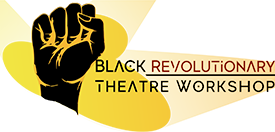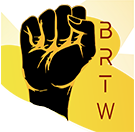BRTW is a year old! We’re walking, talking, and traveling! In celebration of our fledgling company’s first birthday, we’re publishing a series of blog posts about BRTW, art, revolution, and where we’re heading in the 2016-17 season.
When Black Artists Can’t Trust the Art Establishment
Over a year ago, Kevin and I were emotionally and intellectually drained in the onslaught of racialized and “race-blind” media response to the massacre at Mother Emmanuel AME. Like a number of artists, our immediate thought was “What can art do?”
The New York City downtown “progressive” arts scene was quick to respond, and within a few days, we found ourselves in a theatre basement in an intense discussion about race, violence, community, progress, and theatre with a majority of white discussants. Within minutes, anecdotes about allyship, white minorities, and grandparent Holocaust survivors dominated the conversation. These are important topics in their own rights, but they should not have been the focus at that moment. Our Blackness felt endangered. A relatively young man- some would even call him a “kid” in the days after the story broke- engaged in such violent white supremacist terrorism that he murdered nine people, including a prominent senator, in a church.
Taking Shape
We left before the meeting even began to really dig into its agenda. We didn’t trust these white artists enough to collaborate with them- not about this. We thought the impulse was a correct one, however. Regardless of massive defunding efforts sucking arts programs out of schools and soaring ticket prices making the arts virtually inaccessible to certain populations- art is important. Some would say that the representations we see in arts and entertainment form our sense of culture. These representations have certainly informed stereotypes and misconceptions. Being an artist may mean being broke, working around the clock, and facing exploitation on a regular basis, but it also comes with privilege. We get to participate in the shaping, questioning, and dismantling of cultural perception.
At the end of the week, we began the process at the heart of our company. We began investigating current events, history, critical race theory, womanism, and intersectionality. We wanted to create work that didn’t apologize for Blackness (or any identity). It wouldn’t be for another two months before we booked our first commission, which would effectively green light our passions into an endeavor that we could really afford to undertake.
We performed our first full-length production in Bridgeport, CT in October. Four months had passed, and we’d experienced the first major pitfalls of forming a fledgling production company in NYC. Art is an expensive endeavor that comes with tons of criticism and not a lot of pay. It’s a huge gamble for any company, especially one that so aggressively interrogates the status quo.
Here and Now
The first show was a success, as was the second. Now we’re figuring out tour schedules, open rehearsals, booking gigs at home in NYC, and how to manage administrative tasks. We’re still growing and learning, but the point is that we’re still here. We’re not perfect; we’ve made mistakes, but our aggressively Black art thrives, pays, and expands.

